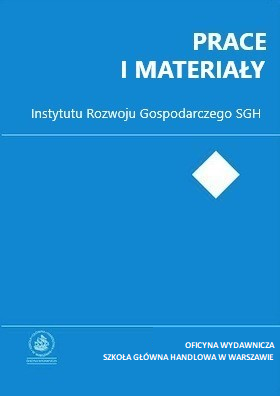Transmission of Business Situation
Main Article Content
Abstract
The current crisis has disclosed constraints to traditional models that neglected the importance of banks and other financial intermediaries in transmission of business situation impulses the crisis has confirmed the key role of financial institutions in proliferating and deepening business situation fluctuations not only in individual countries, which was observed previously, but also in international scale. It is balance sheets of banks that are of major significance for the transmission of business situation impulses. There are at least three reasons for the above. Firstly, the balance sheets of banks are influenced by the credit multiplier. Secondly, the balance sheet has an impact on the use of financial leverage by banks. Thirdly, the state of the balance sheet influences the functioning of interbank market. Moreover, banks are also involved dually in a classic process of infection. One of the ways refers to flock-like behavior, and the other is connected with the institution of the common creditor. All these issues as well as the importance of banks operating across-the-borders for business situation transmission have been discussed in this paper. (original abstract)
Article Details
References
Adrian T., Hyun Song Shin, Liquidity and Financial Contagion, “Banque de France Financial Stability Review – Special Issue on Liquidity” 2008, No. 11.
Agénor P. R., Benefits and Costs of International Financial Integration: Theory and Facts, “World Bank Policy Research Working Paper” 2011, No. 2699.
Allen F., D. Gale, Financial Contagion, “Journal of Political Economy” 2000, No. 1.
Bhattacharya J., The Role of Foreign Banks in Developing Countries: A Survey of Evidence, Cornell University mimeo 1993.
Bikhchandani S., Hirshleifer D., Welch I. Learning from the Behavior of Others: Conformity, Fads, and Informational Cascades, “Journal of Economic Perspectives” 1998, No. 3.
Caballero J., Candelaria Ch., Hale G., Bank Relationships and the Depth of the Current Economic Crisis, “Federal Reserve Bank of San Francisco Economic Letter” 2009, No. 38.
Calvo G., Capital Market Contagion and Recession: An Explanation of the Russian Virus, w: Wanted: World Financial Stability, red. E. Fernández-Arias, R.
Hausmann, Inter-American Development Bank, Washington DC 2000.
Chen Y., Banking Panics: The Role of the First-Come, First-Served Rule and Information Externalities, “Journal of Political Economy” 1999, No. 5.
Dedola L., Lombardo G., Financial Frictions, Financial Integration and the Interna- tional Propagation of Shocks, Working Paper, http://www.hec.unil.ch/documents/seminars/deep/511.pdf Devereux M., Yetman B. J., Leverage Constraints and the International Transmission of Shocks, “Federal Reserve Bank of Dallas Globalization and Monetary Policy Institute Working Paper” 2010, No. 45.
Diamond D. W., Financial Intermediation and Delegated Monitoring: A Simple Example, “Federal Reserve Bank of Richmond Economic Quarterly” 1996, No. 3.
Diamond D. W., Dybvig P. H., Bank Runs, Deposit Insurance, and Liquidity, “Journal of Political Economy” 1983, No. 3.
Diamond D. W., Rajan R. G., Fear of Fire Sales, Illiquidity Seeking, and Credit Freezes, “Quarterly Journal of Economics” 2011, No. 2.
Enders Z., Kollmann R., Müller G., Banks and the Domestic and International Propagation of Macroeconomic and Financial Shocks, 12th Euro Area Business Cycle Network Workshop, Budapest, 28-29 June 2010.
Fostel A., Geanakoplos J., Leverage Cycles and the Anxious Economy, “American Economic Review” 2008, No. 4.
Gai P., Kapadia S., Contagion in Financial Networks, “Bank of England Working Paper“ 2010, No. 383.
Galesi A., Sgherri S., Regional Financial Spillovers Across Europe: A Global VAR Analysis, “IMF Working Paper” 2009, No. 2.
Gambacorta L., Mistrulli P. E., Bank Capital Lending Channel and Lending Behavior: Empirical Evidence for Italy, “Journal of Financial Intermediation” 2004, No. 4.
Haas de R. T. A., Lelyveld van I. P. P., Foreign Bank Penetration and Private Sector Credit in Central and Eastern Europe, “DNB Staff Reports” 2002, No. 91.
Herrero A. G., Navia Simón D., Foreign Banks and Financial Stability in the New Europe, “Banks and Bank Systems” 2006, No. 1.
Heuvel van den J. S., The Bank Capital Channel of Monetary Policy, “Society for Economic Dynamics Meeting Papers” 2006, No. 512.
Hirakata N., Sudo N., Ueda K., Chained Credit Contracts and Financial Accelerators, “IMES Discussion Paper Series” 2009, No. 2009-E-30.
Jeanneau S., Micu M., Determinants of International Bank Lending to Emerging Market Countries, “BIS Working Paper” 2002, No. 112.
Jokipii T., Milne A., The Cyclical Behaviour of European Bank Capital Buffers, “Bank of Finland Research Discussion Papers” 2006, No. 17.
Kaminsky G., Reinhart C., On Crises, Contagion, and Confusion., “Journal of International Economics” 2000, No. 1.
Kjersti-Gro I., Banks’ Buffer Capital: How important is Risk, “Norges Bank Working Paper” 2003, No. 11.
Kodres L., Pritsker M., A Rational Expectations Model of Financial Contagion, “Journal of Finance” 2002, No. 2.
Kollmann R., Malherbe F., International Financial Contagion: The Role of Banks, “Working Papers ECARES” 2011, No. 2011-001.
Krugman P., The International Finance Multiplier, Working Paper, Princeton University 2008.
Lagunoff R., Schreft S., A Model of Financial Fragility, “Journal of Economic Theory” 2001, No. 1-2.
Lane P. R., Milesi-Ferretti G. M., The Cross-Country Incidence of the Global Crisis, “IMF Working Paper Research Department” 2010, No. 171.
Martinez Peria M. S., Powell A., Vladkova-Hollar I., Banking on Foreigners: The Behavior of International Bank Claims on Latin America, 1985–2000, “IMF Staff Papers” 2005, No. 3.
Peek J., Rosengren E. S., The International Transmission of Financial Shocks: The Case of Japan, “American Economic Review” 1997, No. 4.
Rose A. K., Spiegel M., Cross-Country Causes and Consequences of the 2008 Crisis: International Linkages and American Exposure, “NBER Working Paper” 2009, No. 15358.
Shleifer A., Vishny R. W., The Limits of Arbitrage, “Journal of Finance” 1997, No 1.
Schleifer A., Vishny R. W., Liquidation Values and Debt Capacity: A Market Equilibrium Approach, “The Journal of Finance” 1992, No. 4.
Schnabl P., Financial Globalization and the Transmission of Credit Supply Shocks: Evidence from an Emerging Market, “NYU Finance Working Papers” 2009, No.
Fin-08-008.
